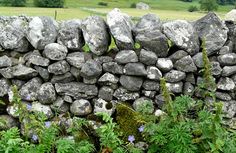Stone walls, ditches and dykes.
Distinctive features of built heritage around Skehana.
Gerry Costello
Stone walls are a common feature throughout the West of Ireland and Skehana and its surrounding areas are no different. Dry stone walls are a feature of many of our townlands where stones were the most common form of fence building while in other townlands a ditch or to give it it’s proper name, a dyke, was the preferred method of fencing and creating a boundary. These simple but effective stone wall structures principally used as field boundaries were also, by default, a useful form of shelter from the wind and rain for some farm animals. Stone walls are a distinctive feature of Ireland’s landscape and it is estimated that we have about a quarter of a million miles of stone walls all over Ireland. Many parts of Ireland and especially Ireland West is naturally a very stony, rocky and mountainous region. it was essential for stone to be cleared away in order that the land be farmed.
The walls were built without mortar and hence are called dry stone walls. To date the oldest known example of dry stone walls in Ireland are at the ‘The Ceide Fields’. These were erected 5,800 years ago. The most common type of wall which one will see in this area is described as a “Single Stone Wall”. This is the most “economic” when it comes to the amount of stones needed. The large stones are placed at the bottom or base and as the wall gets higher the stones usually get smaller. This type of wall is easily knocked down by animals but easily repaired again. In all to the “estate” walls and boundaries between landlords you will notice a better quality wall. They are generally called “Double Stone Walls”. These are built with two faces – a front and a back – with long narrow stones strategically placed to be used as wall ties to keep the two sides bound together. The centre is filled with smaller stones. These are much more difficult to erect, much harder to knock and give a better life span with low maintenance.
For many visitors to Ireland, their abiding memory of the scenery is not the great sweeping seascapes or the ancient mountains shrouded in mist, but these tiny fields emerging from the stony land, surrounded by thousands of miles of stone walls and the enormous efforts it must have taken in both time and labour to put them there in the first place.
Dry stone walls are not merely piles of stones. They live and change with the season. Like a good bottle of wine they improve as they mature, becoming a home for all kinds of wild animals and birds. In the Winter they glow with lichens and mosses and in the Summer they come alive with ferns, grasses many other wild flowers. They are the thread that links the fields of the area to one another and they are also the threads that link the people and, particularly, the Farmers to the land.
Click to hear John perform his song
Dry Stone Walls – Song Lyrics By John Gibbs
The sun is going down behind the hill
And I have toiled all day and have my fill
My back is heavy with that old sandstone
And building dry stone walls
A linnet singing out her evening song
The day was heavy and the day was long
Just like a river meandering fine
Stone after stone they lie there layer after line
Stone after stone they lie there layer after line
A golden chain in sunlight they look so fine
My heart is easy with that old sandstone
And building dry stone walls
The sun is going down behind the hill
Now I am off to Blakey’s to have my fill
My back is heavy with that old sand stone
And building dry stone walls
The Yorkshire moors can be a crystal ball
A gem in sunlight and a beast in storm
A misty morning in the twilight zone
Along those dry stone walls
Stone after stone they lie there layer after line
A golden chain in sunlight they look so fine
My heart is easy with that old sand stone
And building dry stone
And building dry stone
And building dry stone walls.













No Comments
Add a comment about this page